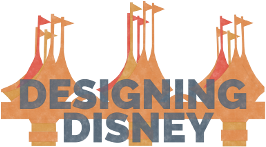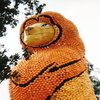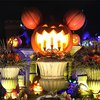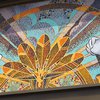Designing "it's a small world" - The 1964 New York World's Fair
The idea for “it’s a small world” had played in Walt Disney’s mind for many years. He wanted to create some sort of show that featured the children of the world singing in harmony and peace. Unfortunately, Walt didn’t have the chance to realize this dream. Until the early sixties…
In 1960 Walt Disney gathered his staff and proposed the idea on offering Disney’s services to the American Corporations who were participating in the soon to be "1964 New York World's Fair”. He realized that some companies were looking for something that would stand out from the others, something brand new, and unique.


By giving companies a chance to hire WED (a company ran by Walt Disney Productions that was in charge of creating rides and attractions for Disneyland) to create and develop their pavilions, Walt would gain financial support to advance and develop theme park technology for his future plans (Walt Disney World). Not only would the technology grow, but all the attractions could be moved to Disneyland when the fair was over.

At first, a team of representatives visited the US's top companies offering Disney's services for the fair. WED was hired to build attractions for Ford Motors, General Electric and the State of Illinois. In February 1963, representatives of Pepsi Cola spoke with Admiral Joe Fewler (Disney Imagineer). Pepsi explained that they wanted to sponsor a pavilion at the upcoming New York World’s Fair in conjunction with Unicef. Walt’s salute to the children of the world would be a perfect match.
Although, with the fair’s opening date only a year away, Fowler turned them down. There simply wasn’t enough time to undertake such an enormous project, especially since the Walt Disney Company was already committed to three other fair projects. When Walt learned that Fowler had sent Pepsi away empty handed, he was furious. He let Fowler know of his displeasure and told Pepsi that Disney was up to the challenge.
Once the exhibit was designed, and fabricated, a "mock-up" was put together at the Disney Studios in California. In March 1963, construction began in New York on the show building. As the Fair deadline grew shorter the mock up, complete, or not, was sent to New York to be tested and finished.


Numerous problems faced WED once everything arrived in New York. To install the attraction, crews (living off black coffee in the morning, and martinis for lunch) worked seven days a week to make the deadline.
The original name of the attraction was to be “The Children of the World”, but after the Sherman Brothers wrote their song, the name was changed to “it’s a small world”.
The fair opened on April 22, 1964 and “it’s a small world” was an immediate success. The ride cost 95 cents for adults and 60 cents for children (with funds going to Unicef). Over the next two years, over ten million guests visited the pavilion. In a rather short period of time, theme-park technology was advanced greatly. With, a minimal expenditure to the Walt Disney Company. By dealing with corporations, and stretching his Imagineers' creativity valuable lessons were learned.


Below is a description of the “it’s a small world” exhibit from the 1965 Official Guide Book to the New York World’s Fair.


A salute to the children of the world, designed by Walt Disney, presents animated figures frolicking in miniature settings of many lands. Visitors are carried past the scenes in small boats. In an adjoining building Pepsi sponsors exhibits by the U.S. Committee for the United Nations Children's Fund. Above the pavilion rises the 120-foot Tower of the Four Winds, a fanciful creation of coloured shapes that dance and twist in the breeze.

The large kinetic sculpture in front of the show building was called “The Tower of the Four Winds”. Designed by Rolly Crump, this 120 foot high steel mobile had over fifty moving object that turned and rotated in the wind. Its endless movement represented the constant energy of young children and this piece of art became one of the fair’s landmarks.


Walt knew all along that once the fair closed, he would move “it’s a small world’ to Disneyland. Construction started in June, 1965 on what would eventually become "it's a small world’s" new home in Anaheim. Unfortunately, the expense of moving “The Tower of the Four Winds” proved to be prohibitive.
“Small World” opened at Disneyland on May 28, 1966 and was sponsored by Bank of America. Besides the Disney and Bank of America dignitaries, there were 36 foreign consular officials, more than 800 members of the press, and the International Children’s Choir of Long Beach. In addition, a parade of local folk dancing groups and marching bands also participated.

Walt Disney joined “children from sixteen ethnic groups” to pour flasks of water from the “seven seas and nine major lagoons” into the waterway for the attraction. The water was authentic and had been flown in at a significant expense from different countries.

In the past decades, “it’s a small world” was build in almost every Disney Theme Park across the globe: Disneyland (California), Magic Kingdom (Florida), Tokyo Disneyland (Japan), Disneyland Park (France) and Hong Kong Disneyland (China). Disneyland's version was closed from January to November, 2008, to receive a major refurbishment. This refurbishment added 29 Disney characters to this true Disney E-Ticket ride.

The New York World's Fair lost a lot of money. It was unable to repay its financial backers their investment, and it became embroiled in legal disputes with its creditors until 1970, when the books were finally closed and the New York World's Fair 1964-1965 Corporation was dissolved.
Most of the pavilions constructed for the fair were demolished within six months following the fair's close. Only a handful of pavilions survived. Some of them deteriorated due to neglect.


Credits
Photo overview fair:
- Gorillas don't Blog









